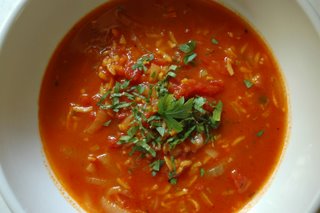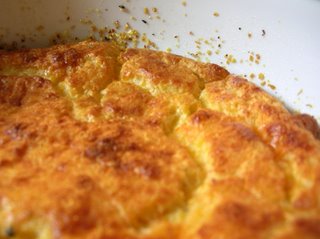When I was a freshman in college, I subsisted solely upon Grape-Nuts, Veggie Burgers, Grilled Cheese and Tater Tots. Oh, what a happy day Grilled Cheese Day was! I had friends that would eat 5 or 6 at a time! Occasionally, the cafeteria gods would smile upon us suffering underclassmen, and they would proclaim that we should be served something
different....something healthy, but tasty....and they would serve us Stuffed Peppers. In Kittridge Hall, they would stuff green peppers with couscous and vegetables...they were a little boring, so I'd always top them with whatever soup or pasta sauce was offered that day. Dorm room living wasn't glamorous, but it sure was easy, wasn't it?
I would hardly say that stuffed peppers were ever a favorite of mine, but in the dredges of a freshman diet, they create an excitement that is surpassed only by a meal eaten OUTSIDE the dorms. This is no shining introduction to our recent dinner of Stuffed Peppers with Spicy Collards and Scallion Pilaf, but it is the truth. Stuffed Peppers have a pretty homely reputation, and it is for good reason. Vegetarian versions still carry with them that 70's veggie vibe that scares most people away from "vegetarian" eating. BUT, if something is good, and it happens to be meat free, then most people will gladly forget their carnivorous ways.
Dustin and I don't eat meat that often, and it's especially easy to forgo eating meat during the summer, when there is produce knocking down the door, and taking over the refrigerator. Lately we've eaten some fantastic vegetarian meals, like Zucchini and Corn Enchiladas, from Fields of Greens, Mediterranean Panzanella from Martha Stewart, and Linguine with Parsley-Mint Pesto, from this month's Food and Wine. These stuffed peppers came from Food and Wine as well, and were featured in their regular Well-Being section, in an article about cookbook writer Celia Brooks Brown. I changed the recipe according to what I had on hand, and added a quick yogurt sauce flavored with chives, lemon juice, honey and cayenne pepper. It turned out to be a delicious and virtuous dinner, which I love, because it left plenty of room for dessert. More on that later.

I'd say that stuffed peppers are the the most flexible dish in the world - add whatever you have in your fridge, but just make sure you add some texture and some serious flavor, or they can turn out a little bland. I'd also recommend cooking them long enough that the peppers get really nice and soft... if they are still a bit toothsome, they will lack depth of flavor. It is helpful to make the stuffing ahead of time, if you want to cook this on a weeknight, because of the long cooking time.
Stuffed Peppers with Spicy Greens and Scallion PilafAdapted from Food and Wine, Celia Brooks Brown, Aug 20061 1/2 cups short-grain brown or white rice, rinsed and drained, cooked according to package directions
3/4 lb Swiss Chard or Collards, trimmed, ribs discarded
1/4 cup extra virgin olive oil
6 medium scallions, thinly sliced
2 garlic cloves
3/4 teaspoon tumeric
3/4 teaspoon ground cumin
3/4 teaspoon ground ginger
1/4 teaspoon cinnamon
1/4 teaspoon cayenne pepper
1 medium tomato, diced
3 tablespoons currants, soaked in white wine if desired
3 tabelspoons pine nuts, toasted
Fresh lemon juice
Salt and Pepper
4 Yellow or Orange Peppers
1 cup veggie or chicken broth, or 1/2 broth, 1/2 white wine
For Yogurt Sauce1/2 cup Greek yogurt
2 tablespoons minced chives
1 tablespoon lemon juice
1 tablespoon honey
pinch of cayenne
Preheat oven to 400 degrees.
In a large skillet, heat 1/2 inch water to a boil. Add the chard or collards and cook until tender, about 2-3 minutes. Drain and let cool, then squeeze dry and coarsely chop.
Heat the olive oil in the same skillet over moderate heat. Add the scallions and garlic and cook until softened and fragrant. Season with salt and pepper, and then add the spices and cook, stirring, another 2 minutes. Deglaze the pan with a little white wine, if you happen to have some on hand, or in hand! Add the chard and currants and cook until the liquid evaporates. Add the chopped tomato and cook a few minutes longer. Remove the skillet from the heat and add the cooked rice. Squeeze a few tablespoons of fresh lemon juice over the mixture. Season with salt and pepper.
Cut the tops off the peppers and reserve. Scoop out the seeds and ribs. Spoon the rice filling into the peppers and replace the tops. Stand the peppers in a baking dish that will hold them snuggly, and pour in the broth (and wine if using). Cover tightly with foil and bake 1 hour, or longer, until the peppers are tender. Serve warm or at room temperature.


















